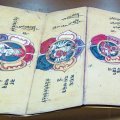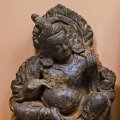Patan Museum (Nepal): photo 156
Photo 156 of 212 in Gallery: Patan Museum (Nepal)

Image title: The Divine Play of Lord Krishna
Description of the photo
This painting shows an image of The Divine Play of Lord Krishna, from the mid-17th century origination from Nepal.—Materials used: Opaque watercolors on cotton cloth.
This painting illustrates the text of thirty-one devotional songs, a genre known as Krishnalila. They concern the divine play (lila) of Lord Krishna, a beloved incarnation of Vishnu. The songs are said to have been composed by Siddhi Narasimha Malla, ruler of the Patan kingdom from 1619 to 1661 but they are strongly influenced by classical Indian poetry.
The painting is arranged in five narrative registers, to be viewed from left to right, top to bottom. Each register contains several scenes, separated by exotic vegetation and set against a background of snow-cappped mountains. Krishna—colored blue, of superhuman size, and often playing his flute—appears several times (the second upper left scene, for example). He is sometimes in company with gopis, adoring milkmaids who in the songs lament their unrequited love. The first scene depicts Shiva, his consort Gauri, his mount Nandi, two attendants and, far right, King Siddhi Narasimha Malla. The king and the numerous gopis wear Mughal-style dress like that worn at the late Malla Period courts.
The devotional songs are written in old Newari above the corresponding scenes. With one exception—the fourteenth-century Gopala Chronicle—they are the oldest Newari ds texts to be critically studied and translated.
For many years this painting has been displayed annually in front of the nearby Krishna temple on the day of the May-June full moon—the lunar month of Jyestha—when to instrumental accompaniment the devotional songs are sung in Krishna’s honor. Siddhi Narasimha had this temple built for Krishna in 1637.
Gallery information:
The Patan Museum is located on the Durbar square of Patan (Lalitpur/Lalitapura, Kathmandu, Nepal) which is associated Keshav Narayan Chowk (Keshavnarayan)—a form of Lord Vishnu. Being listed as a World Heritage Site, the whole of Durbar square is filled with exquisite temples, sculptures and other ancient structures, of which the ancient history history can be traced to the Malla Kings of Lalitpur. It is an important site for both Buddhism and Hinduism.
Photo details:
Date: 2019-12-02
Camera: SONY ILCE-6400
Exposure: 1/20
Aperture: f/5
ISO: 200
Focal length: 18mm
High resolution:
Download file
Size: 8.00 MB
Resolution: 3961 x 3284
© Photograph by Gabe Hiemstra.
License: CC BY-NC-ND 4.0

